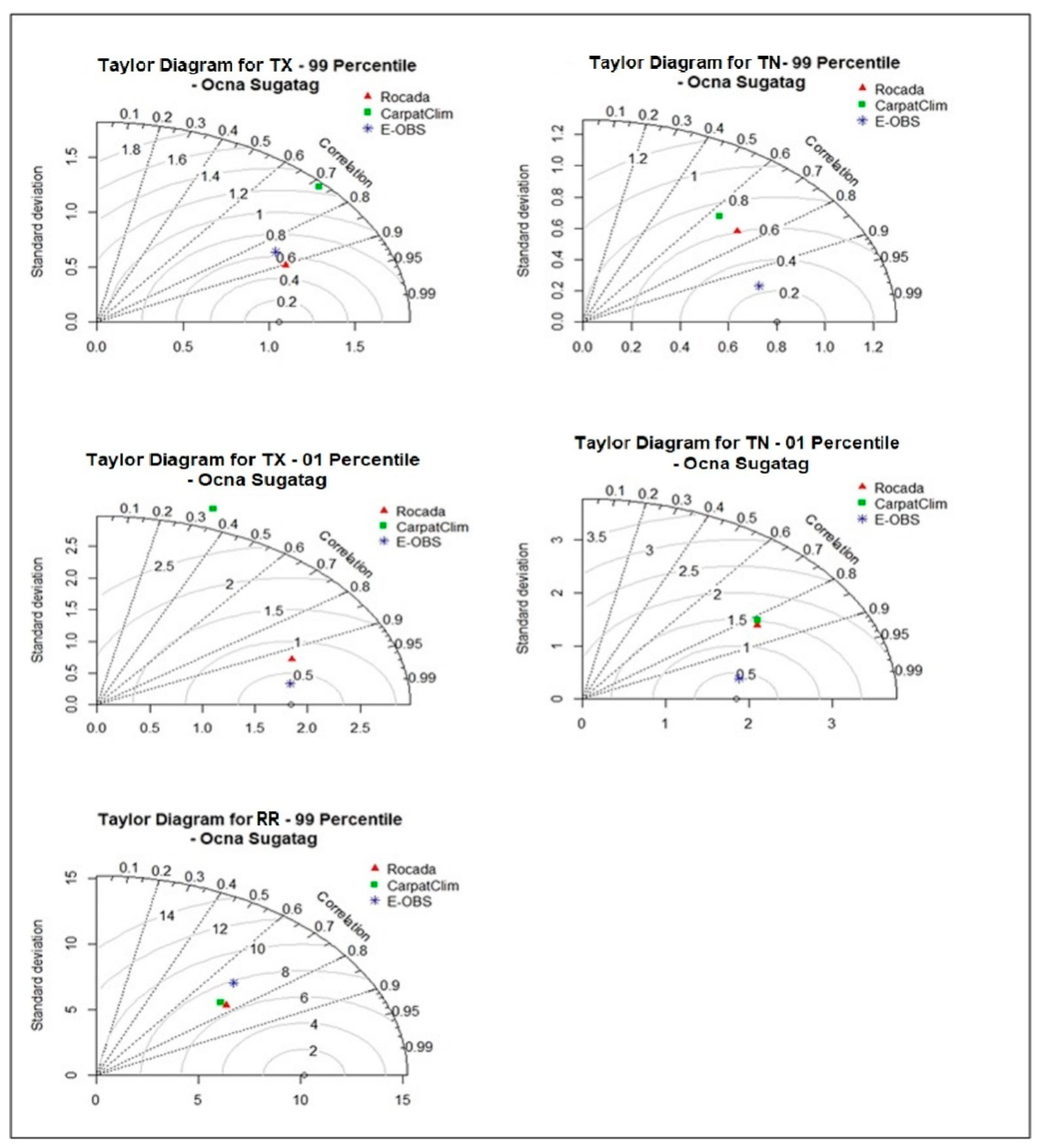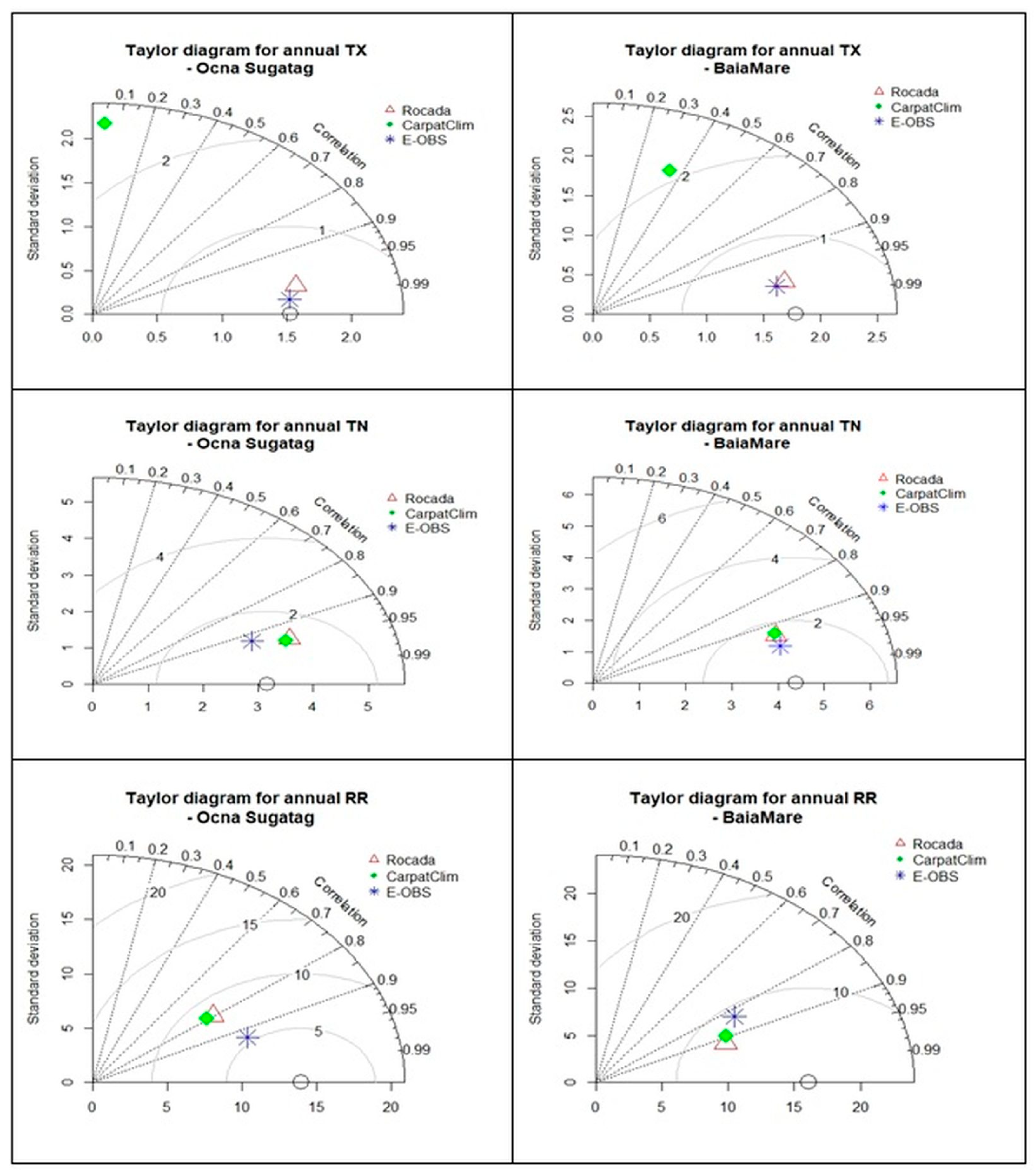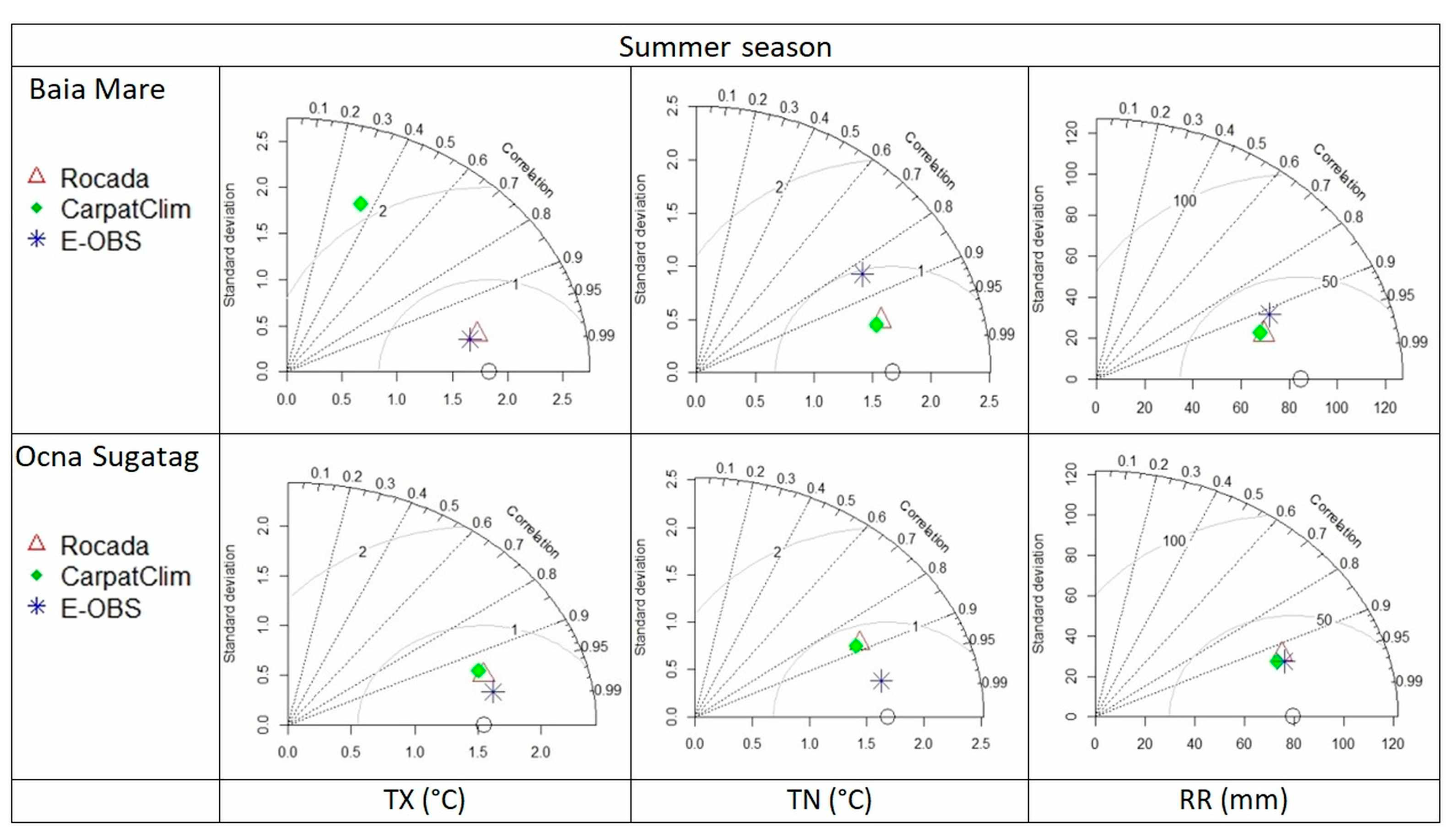Comparative Analysis between Daily Extreme Temperature and Precipitation Values Derived from Observations and Gridded Datasets in North-Western Romania
Abstract
1. Introduction
2. Materials and Methods
2.1. Data Used
2.1.1. Observation Data
2.1.2. Gridded Data
2.2. Methods
2.2.1. Descriptive Statistics
2.2.2. Comparison between the Extreme Values Derived from Gridded Datasets and from Observations Using the Complete Datasets
2.2.3. Comparison between Seasonal Values Derived from Gridded Datasets and from Observations
2.2.4. Trend Analysis
3. Results and Discussions
3.1. Study Region
3.2. Analysis of the Historical Extreme Temperatures and Precipitation
3.3. Descriptive Statistics
3.4. Correlation and Determination Analysis of Datasets
3.5. Taylor Diagrams-Based Analysis
3.6. Linear Regression for the 1st and 99th Percentiles
3.7. Analysis of the Extreme Annual Values
3.8. Analysis of the Annual Seasonal Values
3.8.1. Kolmogorov-Smirnov Test (K-S) Distribution Analysis
3.8.2. Taylor Diagram Analysis
3.8.3. Trend Detection
4. Conclusions
Author Contributions
Funding
Institutional Review Board Statement
Informed Consent Statement
Data Availability Statement
Acknowledgments
Conflicts of Interest
References
- Dumitrescu, A.; Bîrsan, M.V. ROCADA: A gridded daily climatic dataset over Romania (1961–2013) for nine meteorologi-cal variables. Nat. Hazards 2015, 78, 1045–1063. [Google Scholar] [CrossRef]
- Gulizia, C.; Camilloni, I.A. Spatio-temporal comparative study of the representation of pre-cipitation over South America derived by three gridded datasets. Int. J. Climatol. 2015, 36, 1549–1559. [Google Scholar] [CrossRef]
- Haylock, M.R.; Hofstra, N.; Tank, A.M.G.K.; Klok, E.J.; Jones, P.D.; New, M. A European daily high-resolution gridded data set of surface temperature and precipitation for 1950–2006. J. Geophys. Res. Space Phys. 2008, 113, 113. [Google Scholar] [CrossRef]
- Costa, A.C.; Soares, A. Homogenization of climate data: Review and new perspectives using geostatistics. Math. Geol. 2009, 41, 291–305. [Google Scholar] [CrossRef]
- Sluiter, R. Interpolation Methods for the Climate Atlas. KNMI. 2012. 71 p. IR 2009-04. Available online: https://www.semanticscholar.org/paper/Interpolation-Methods-for-the-Climate-Atlas-Sluiter/853b4f9af8b27e4b345e3128b7e69036326979a7 (accessed on 29 September 2020).
- Singh, H.; Najafi, M.R. Evaluation of gridded climate datasets over Canada using univariate and bivariate approaches: Implications for hydrological modelling. J. Hydrol. 2020, 584, 124673. [Google Scholar] [CrossRef]
- Aieb, A.; Madani, K.; Scarpa, M.; Bonaccorso, B.; Lefsih, K. A new approach for processing climate missing databases applied to daily rainfall data in Soummam watershed, Algeria. Heliyon 2019, 5, e01247. [Google Scholar] [CrossRef]
- Bartók, B.; Tobin, I.; Vautard, R.; Vrac, M.; Jin, X.; Levavasseur, G.; Denvil, S.; Dubus, L.; Parey, S.; Michelangeli, P.-A.; et al. A climate projection dataset tailored for the European energy sector. Clim. Serv. 2019, 16, 100138. [Google Scholar] [CrossRef]
- Darand, M.; Khandu, K. Statistical evaluation of gridded precipitation datasets using rain gauge observations over Iran. J. Arid. Environ. 2020, 178, 104172. [Google Scholar] [CrossRef]
- Ekström, M.; Grose, M.; Heady, C.; Turner, S.; Teng, J. The method of producing climate change datasets impacts the resulting policy guidance and chance of mal-adaptation. Clim. Serv. 2016, 4, 13–29. [Google Scholar] [CrossRef]
- Faiz, M.A.; Liu, D.; Fu, Q.; Sun, Q.; Li, M.; Baig, F.; Li, T.; Cui, S. How accurate are the performances of gridded precipitation data products over Northeast China? Atmos. Res. 2018, 211, 12–20. [Google Scholar] [CrossRef]
- Yao, J.; Chen, Y.; Yu, X.; Zhao, Y.; Guan, X.; Yang, L. Evaluation of multiple gridded precipitation datasets for the arid region of northwestern China. Atmos. Res. 2020, 236, 104818. [Google Scholar] [CrossRef]
- Musie, M.; Sen, S.; Srivastava, P. Comparison and evaluation of gridded precipitation datasets for streamflow simulation in data scarce watersheds of Ethiopia. J. Hydrol. 2019, 579, 124168. [Google Scholar] [CrossRef]
- Nashwan, M.S.; Shahid, S. Symmetrical uncertainty and random forest for the evaluation of gridded precipitation and temperature data. Atmos. Res. 2019, 230, 104632. [Google Scholar] [CrossRef]
- Serrano-Notivoli, R.; De Luis, M.; Beguería, S. An R package for daily precipitation climate series reconstruction. Environ. Model. Softw. 2017, 89, 190–195. [Google Scholar] [CrossRef]
- Nechita, C.; Čufar, K.; Macovei, I.; Popa, I.; Badea, O.N. Testing three climate datasets for dendroclimatological studies of oaks in the South Carpathians. Sci. Total Environ. 2019, 694, 133730. [Google Scholar] [CrossRef]
- Szentimrey, T.; Bihari, Z. Manual of interpolation software MISHv1.03. In Hungarian Meteorological Service; Hungarian Meteorological Service: Budapest, Hungary, 2014; p. 89. [Google Scholar]
- Soares, M.B.; Alexander, M.; Dessai, S. Sectoral use of climate information in Europe: A synoptic overview. Clim. Serv. 2018, 9, 5–20. [Google Scholar] [CrossRef]
- Sfîcă, L.; Stratulat, I.S.; Hrițac, R.; Ichim, P.; Ilie, N. Favorabilitatea climatică a teritoriului României pentru activități turistice de tip balnear în sezonul estival. In Stratulat, IS Coord—Balneoclimatologia în România și Republica Moldova—Istoric și Perspective Europene; Editura Academiei Române: Bucharest, Romania, 2018; Volume 409, pp. 327–347. ISBN 978-973-27-3005-8. [Google Scholar]
- Sfîcă, L.; Iordache, I.; Voiculescu, M. Solar signal on regional scale: A study of possible solar impact upon Romania’s climate. J. Atmos. Solar-Terr. Phys. 2018, 177, 257–265. [Google Scholar] [CrossRef]
- Dobri, R.-V.; Sfîcă, L.; Ichim, P.; Harpa, G.-V. The distribution of the monthly 24-hour maximum amount of precipitation in romania according to their synoptic causes. Geogr. Tech. 2017, 12, 62–72. [Google Scholar] [CrossRef][Green Version]
- Tank, A.M.G.K.; Wijngaard, J.B.; Können, G.P.; Böhm, R.; Demarée, G.; Gocheva, A.; Mileta, M.; Pashiardis, S.; Hejkrlik, L.; Kern-Hansen, C.; et al. Daily dataset of 20th-century surface air temperature and precipitation series for the European Climate Assessment. Int. J. Clim. 2002, 22, 1441–1453. [Google Scholar] [CrossRef]
- European Climate Assessment and Datasets. Available online: www.ecad.eu (accessed on 23 March 2020).
- Climate of the Carpathian Region. Available online: http://www.carpatclim-eu.org (accessed on 15 January 2020).
- Croitoru, A.E.; Piticar, A.; Sfîcă, L.; Harpa, G.V.; Roșca, C.F.; Tudose, T.; Horvath, C.; Minea, I.; Ciupertea, F.A.; Scripcă, A.S. Extreme Temperature and Precipitation Events in Romania; Editura Academiei Române: Bucharest, Romania, 2018. [Google Scholar]
- Szalai, S.; Auer, I.; Hiebl, J.; Milkovich, J.; Radim, T.; Stepanek, P.; Zahradnicek, P.; Bihari, Z.; Lakatos, M.; Szentimrey, T.; et al. Climate of the Greater Carpathian Region; Final Technical Report; Publications Office of the European Union: Budapest, Hungary, 2013. [Google Scholar]
- Szentimrey, T.; Bihari, Z. Manual of interpolation software MISHv1.01. In Hungarian Meteorological Service; Hungarian Meteorological Service: Budapest, Hungary, 2005. [Google Scholar]
- Szentimrey, T. Manual of homogenization software MASHv3. In Hungarian Meteorological Service; Hungarian Meteorological Service: Budapest, Hungary, 2011. [Google Scholar]
- Description of MASH and MISH Algorithms. Available online: http://www.carpatclim-eu.org/docs/mashmish/mashmish.pdf (accessed on 15 March 2020).
- Cornes, R.C.; Van Der Schrier, G.; Besselaar, E.J.M.V.D.; Jones, P.D. An ensemble version of the E-OBS temperature and precipitation data sets. J. Geophys. Res. Atmos. 2018, 123, 9391–9409. [Google Scholar] [CrossRef]
- Taylor, K.E. Summarizing multiple aspects of model performance in a single diagram. J. Geophys. Res. Atmos. 2001, 106, 7183–7192. [Google Scholar] [CrossRef]
- Engmann, S.; Cousineau, D. Comparing distributions: The two-sample Anderson–Darling test as an alternative to the Kolmogorov–Smirnov test. J. Appl. Quant. Methods 2011, 6, 1–17. [Google Scholar]
- Mann, H.B. Non-parametric tests against trend. Econometrica 1945, 13, 245–259. [Google Scholar] [CrossRef]
- Kendall, M.G. Rank Correlation Methods, 4th ed.; Charles Griffin: London, UK, 1975. [Google Scholar]
- Gilbert, R.O. Statistical Methods for Environmental Pollution Monitoring; John Wiley & Sons: Hoboken, NJ, USA, 1987. [Google Scholar]
- Wu, W.; Dessler, A.E.; North, G.R. Analysis of the correlations between atmospheric boundary-layer and free-tropospheric temperatures in the tropics. Geophys. Res. Lett. 2006, 33, L20707. [Google Scholar] [CrossRef]
- Some’E, B.S.; Ezani, A.; Tabari, H. Spatiotemporal trends and change point of precipitation in Iran. Atmos. Res. 2012, 113, 1–12. [Google Scholar] [CrossRef]
- Tabari, H.; Nikbakht, J.; Talaee, P.H. Identification of trend in reference evapotranspiration series with serial dependence in Iran. Water Resour. Manag. 2012, 26, 2219–2232. [Google Scholar] [CrossRef]
- Tabari, H.; Aghajanloo, M.-B. Temporal pattern of aridity index in Iran with considering precipitation and evapotranspiration trends. Int. J. Clim. 2013, 33, 396–409. [Google Scholar] [CrossRef]
- Salmi, T.; Määttä, A.; Anttila, P.; Ruoho-Airola, T.; Amnell, T. Detecting trends of annual values of atmospheric pollutants by the Mann-Kendall Test and Sen’s solpe estimates the excel template application MAKESENS. Publ. Air Qual. 2002, 7, 31. [Google Scholar]
- Wang, C.; Wang, Z.-H. A network-based toolkit for evaluation and intercomparison of weather prediction and climate modeling. J. Environ. Manag. 2020, 268, 110709. [Google Scholar] [CrossRef]









| Meteorological Stations | Longitude (°) | Latitude (°) | Altitude (m) |
|---|---|---|---|
| Ocna Șugatag | 23.94214 | 47.77737 | 503 |
| Baia Mare | 23.49324 | 47.66121 | 196 |
| Statistics | TX (°C) | TN (°C) | RR (mm) | |||||||||
|---|---|---|---|---|---|---|---|---|---|---|---|---|
| Observation | Rocada | Carpat Clim | E-OBS | Observation | Rocada | Carpat Clim | E-OBS | Observation | Rocada | Carpat Clim | E-OBS | |
| Mean | 15.16 | 15.16 | 16.13 | 15.12 | 5.32 | 4.69 | 4.72 | 5.17 | 2.47 | 2.09 | 2.13 | 2.12 |
| Standard Error | 0.075 | 0.076 | 0.078 | 0.074 | 0.059 | 0.060 | 0.060 | 0.059 | 0.04 | 0.032 | 0.032 | 0.034 |
| Median | 16.2 | 16.3 | 17.48 | 16.17 | 6.1 | 5.47 | 5.53 | 5.95 | 0 | 0.15 | 0.14 | 0 |
| Mode | 24 | 26.33 | 24.68 | 23.72 | 10 | 0.57 | 10.64 | 10.06 | 0 | 0 | 0 | 0 |
| Standard Deviation | 10.08 | 10.24 | 10.48 | 10.03 | 8.03 | 8.07 | 8.12 | 7.94 | 5.70 | 4.31 | 4.37 | 4.54 |
| Sample Variance | 101.63 | 104.88 | 109.75 | 100.60 | 64.42 | 65.12 | 65.94 | 63.06 | 32.43 | 18.61 | 19.13 | 20.64 |
| Kurtosis | −0.98 | −1.01 | −1.07 | −0.99 | −0.14 | −0.04 | −0.07 | −0.16 | 30.99 | 23.12 | 22.46 | 25.80 |
| Skewness | −0.22 | −0.23 | −0.23 | −0.22 | −0.52 | −0.55 | −0.56 | −0.52 | 4.30 | 3.83 | 3.79 | 3.85 |
| Range | 53.7 | 54.53 | 53.59 | 53.25 | 54.8 | 50.18 | 50.1 | 53.29 | 121.4 | 77.25 | 76.09 | 92.7 |
| Minimum | −16.1 | −16.81 | −13.48 | −16.04 | −29.9 | −28.59 | −28.68 | −29.01 | 0 | 0 | 0 | 0 |
| Maximum | 37.6 | 37.72 | 40.11 | 37.21 | 24.9 | 21.59 | 21.42 | 24.28 | 121.4 | 77.25 | 76.09 | 92.7 |
| Confidence level (95%) | 0.146 | 0.149 | 0.152 | 0.145 | 0.116 | 0.117 | 0.118 | 0.115 | 0.083 | 0.063 | 0.064 | 0.066 |
| Statistics | TX (°C) | TN (°C) | RR (mm) | |||||||||
|---|---|---|---|---|---|---|---|---|---|---|---|---|
| Obser-vation | Rocada | Carpat Clim | E-OBS | Obser-vation | Rocada | Carpat Clim | E-OBS | Obser-vation | Rocada | Carpat Clim | E-OBS | |
| Mean | 13.20 | 14.24 | 15.70 | 12.51 | 3.80 | 4.31 | 4.05 | 3.25 | 2.05 | 2.02 | 2.11 | 2.07 |
| Standard Error | 0.072 | 0.073 | 0.079 | 0.072 | 0.059 | 0.061 | 0.061 | 0.058 | 0.036 | 0.032 | 0.032 | 0.033 |
| Median | 14.2 | 15.24 | 16.97 | 13.50 | 4.6 | 5.08 | 4.89 | 4.04 | 0 | 0.15 | 0.190 | 0 |
| Mode | 21 | 24.99 | 25.43 | 21.49 | 10 | 6.87 | 10.92 | -0.51 | 0 | 0 | 0 | 0 |
| Standard Deviation | 9.53 | 9.66 | 10.44 | 9.46 | 7.78 | 8.05 | 8.07 | 7.75 | 4.87 | 4.24 | 4.32 | 4.39 |
| Sample Variance | 90.86 | 93.40 | 109.07 | 89.58 | 60.52 | 64.72 | 65.17 | 60.11 | 23.72 | 17.94 | 18.63 | 19.28 |
| Kurtosis | −0.972 | −1.006 | −1.070 | −0.981 | −0.387 | −0.254 | −0.238 | −0.360 | 33.635 | 24.102 | 21.729 | 24.166 |
| Skewness | −0.214 | −0.194 | −0.225 | −0.204 | −0.479 | −0.511 | −0.534 | −0.483 | 4.656 | 4.005 | 3.837 | 3.894 |
| Range | 50.6 | 51.69 | 53.59 | 50.41 | 46.6 | 47.78 | 47.06 | 45.98 | 82.2 | 67.74 | 65.8 | 76.5 |
| Minimum | −15.6 | −15.5 | −13.48 | −16.25 | −25.7 | −27.24 | −26.93 | −26.65 | 0 | 0 | 0 | 0 |
| Maximum | 35.0 | 36.2 | 40.1 | 34.2 | 20.9 | 20.5 | 20.1 | 19.3 | 82.2 | 67.7 | 65.8 | 76.5 |
| Confidence level (95%) | 0.142 | 0.144 | 0.155 | 0.141 | 0.116 | 0.120 | 0.120 | 0.114 | 0.071 | 0.062 | 0.063 | 0.064 |
| Variable | Gridded Dataset | MS Baia Mare | MS Ocna Șugatag |
|---|---|---|---|
| TX | ROCADA | 0.998 | 0.997 |
| CARPATCLIM | 0.949 | 0.997 | |
| E-OBS | 0.996 | 0.999 | |
| TN | ROCADA | 0.995 | 0.992 |
| CARPATCLIM | 0.994 | 0.994 | |
| E-OBS | 0.989 | 0.998 | |
| RR | ROCADA | 0.954 | 0.888 |
| CARPATCLIM | 0.952 | 0.892 | |
| E-OBS | 0.913 | 0.925 |
| Variable | Gridded Dataset | MS Baia Mare | MS Ocna Șugatag |
|---|---|---|---|
| TX | ROCADA | 0.7983 * | 0.8895 |
| CARPATCLIM | 0.4994 | 0.2806 | |
| E-OBS | 0.7267 | 0.9542 | |
| TN | ROCADA | 0.4981 | 0.5445 |
| CARPATCLIM | 0.4667 | 0.4097 | |
| E-OBS | 0.1018 | 0.9073 | |
| RR | ROCADA | 0.6779 | 0.5855 |
| CARPATCLIM | 0.6374 | 0.5447 | |
| E-OBS | 0.3458 | 0.475 |
| Variable | Gridded Dataset | MS Baia Mare | MS Ocna Șugatag |
|---|---|---|---|
| TX | ROCADA | 0.7958 * | 0.8677 |
| CARPATCLIM | 0.1096 | 0.1132 | |
| E-OBS | 0.7367 | 0.9678 | |
| TN | ROCADA | 0.6423 | 0.6951 |
| CARPATCLIM | 0.6035 | 0.6676 | |
| E-OBS | 0.8784 | 0.9585 |
| Weather Station | Database | Winter Season | Summer Season | ||||
|---|---|---|---|---|---|---|---|
| TX | TN | RR | TX | TN | RR | ||
| Baia Mare | ROCADA | 0.20 * | 0.22 | 0.42 | 0.12 | 0.10 | 0.20 |
| CARPATCLIM | 0.22 | 0.20 | 0.4 | 0.36 | 0.10 | 0.24 | |
| E-OBS | 0.20 | 0.08 | 0.32 | 0.10 | 0.12 | 0.20 | |
| Ocna Șugatag | ROCADA | 0.32 | 0.12 | 0.54 | 0.56 | 0.14 | 0.22 |
| CARPATCLIM | 0.42 | 0.18 | 0.52 | 0.58 | 0.16 | 0.18 | |
| E-OBS | 0.26 | 0.20 | 0.20 | 0.34 | 0.22 | 0.12 | |
| Weather Station | Baia Mare | Ocna Șugatag | ||||||
|---|---|---|---|---|---|---|---|---|
| Time Series | Observations | ROCADA | CarpatClim | E-OBS | Observations | ROCADA | Carpat Clim | E-OBS |
| TX(°C/year) | 0.052 * | 0.058 | −0.015 | 0.049 | 0.050 | 0.055 | 0.054 | 0.048 |
| TN(°C/year) | 0.037 | 0.035 | 0.030 | 0.035 | 0.036 | 0.030 | 0.030 | 0.034 |
| RR(mm/year) | 0.470 | 0.202 | 0.173 | −0.540 | 0.535 | 0.385 | 0.305 | −0.248 |
| Weather Station | Baia Mare | Ocna Șugatag | ||||||
|---|---|---|---|---|---|---|---|---|
| Time Series | Observations | ROCADA | CarpatClim | E-OBS | Observations | ROCADA | Carpat Clim | E-OBS |
| TX(°C/year) | 0.067 * | 0.064 | −0.033 | 0.033 | 0.056 | 0.048 | 0.052 | 0.048 |
| TN(°C/year) | 0.100 | 0.049 | 0.050 | 0.082 | 0.065 | 0.047 | 0.053 | 0.059 |
| RR(mm/year) | 0.733 | 0.339 | 0.452 | −1.409 | −0.007 | 0.550 | 0.430 | −0.692 |
Publisher’s Note: MDPI stays neutral with regard to jurisdictional claims in published maps and institutional affiliations. |
© 2021 by the authors. Licensee MDPI, Basel, Switzerland. This article is an open access article distributed under the terms and conditions of the Creative Commons Attribution (CC BY) license (http://creativecommons.org/licenses/by/4.0/).
Share and Cite
Sidău, M.R.; Croitoru, A.-E.; Alexandru, D.-E. Comparative Analysis between Daily Extreme Temperature and Precipitation Values Derived from Observations and Gridded Datasets in North-Western Romania. Atmosphere 2021, 12, 361. https://doi.org/10.3390/atmos12030361
Sidău MR, Croitoru A-E, Alexandru D-E. Comparative Analysis between Daily Extreme Temperature and Precipitation Values Derived from Observations and Gridded Datasets in North-Western Romania. Atmosphere. 2021; 12(3):361. https://doi.org/10.3390/atmos12030361
Chicago/Turabian StyleSidău, Mugurel Raul, Adina-Eliza Croitoru, and Diana-Elena Alexandru. 2021. "Comparative Analysis between Daily Extreme Temperature and Precipitation Values Derived from Observations and Gridded Datasets in North-Western Romania" Atmosphere 12, no. 3: 361. https://doi.org/10.3390/atmos12030361
APA StyleSidău, M. R., Croitoru, A.-E., & Alexandru, D.-E. (2021). Comparative Analysis between Daily Extreme Temperature and Precipitation Values Derived from Observations and Gridded Datasets in North-Western Romania. Atmosphere, 12(3), 361. https://doi.org/10.3390/atmos12030361








